|
AZTEC RUINS
Excavation of a Portion of the East Ruins, Aztec Ruins National Monument, New Mexico |

|
ARTIFACTS
Stone
Projectile Points (Plate 25)
Only four complete and fragmentary projectile points were recovered. All are made from flakes with fine chipping and pressure retouching. They are small, triangular, side notched, stem slightly wider than shoulder, and the stems have straight sides and bases. All four points are of a type common to Pueblo III. Lengths range from three-fourths inch to one inch, width, one-half inch. Materials are red jasper, brownish yellow ??? sand, and chalcedony. Two were from the excavations and two were surface finds.
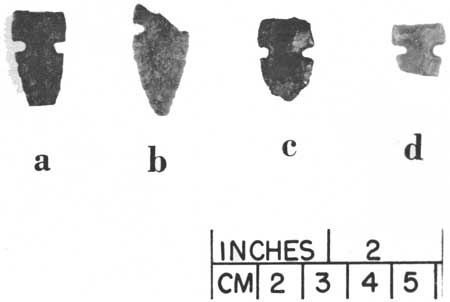
|
| PLATE 25—Projectile points Triangular projectile points. Side-notched, stem wider than shoulder, thin and slender. A — upper Room 14; B — upper Room 11; C and D — miscellaneous surface finds. |
Grooved Axes (plate 26)
River boulders of igneous or metamorphosed rock, selected for size and shape, furnished material for the six specimens recovered during the excavation. With one or two exceptions, workmanship is rather poor and there was a tendency to use the stone unmodified except for the hafting groove (plate 26A). Two principal types may be distinguished on basis of the groove: (1) full groove extending around both sides and faces, and (2) partial grooves or notches, on both the inner and outer sides only. Three of the axes are full-grooved (plate 26C, D, and E), and three are side-notched (plates 26A and B, and plate 27D). Two are made of quartzite, three of olive gray basaltic porphyry, and one of black basaltic porphyry. The latter is double-bitted, or was originally intended for such until the bit for one edge broke and it became a poll hammer. All of the other five specimens are single-bitted axes, the grooves or notches always fashioned closer to the poll than to the bit. In the case of the double-bitted ax, the groove was central with respect to the bits. In all cases, the polls show use as hammers. All of the axes except the side-notched example, whose cutting edge is broken, show grinding facets along the faces near the bits made during manufacture. One ax (plate 26D) is outstanding for its workmanship and careful shaping.
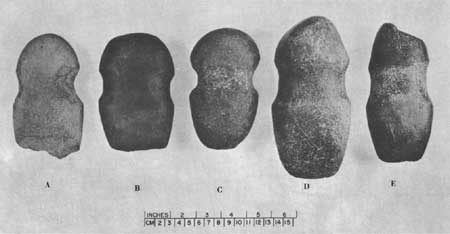
|
| PLATE 26—Axes A and B — side-notched axes; C through E — full-grooved axes. A — from fill between Floors 1 and 2 in kiva over Room 1; B, C, and E — from lower Room 11; D — from lower Room 14. |
Manos
Metates were not found in any of the rooms, and there were only two manos—one complete and the other broken The specimen from lower Room 14 (plate 27A) came from the floor. It is flat, subrectangular, made of green, medium grained, hard sandstone. Upper face shows peck marks and was not used for grinding. The nether side has two smooth adjoining grinding surfaces on one face, slightly concave producing a slightly lozenge-shaped transverse cross-section. There is a suggestion of finger grips on the leading edge. Length: 9-3/8 inches; greatest width: 4-3/4 inches; greatest thickness: five-eighths inch. It was obviously much used, which reduced it to a very thin slab.
The example in plate 27B, came from the fill in lower Room 9. Broken transversely, it was once a large two-handed mano, made of brownish conglomerate quartzite. Rectangular, with rounded corners, in longitudinal cross-section as well as in shape, it has two opposite grinding surfaces, and there are finger grips on both leading and trailing edges. Edges are parallel. Length: 5-1/2 inches; width: 5 inches; thickness: 1 inch.
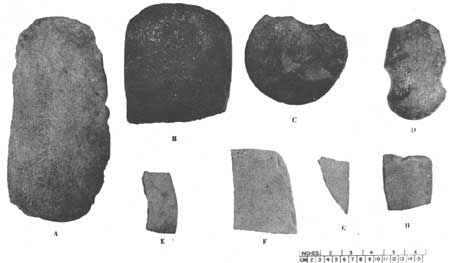
|
| PLATE 27—Stone artifacts. A and B — two-handed manos; C — pot lid; D — side-notched ax; E and H — worked sandstone fragments, portions of niche covers. |
Pot Lid
A single specimen came from the floor of lower Room 14 (plate 27C). It is a fairly thin disc of graywacke, a dark green indurated sandstone, which, incidentally, is the same material forming the decorative (?) band of masonry along the midsection of the west wall of the West Ruin. The edge as well as both surfaces has been shaped by chipping and grinding. It is 4-1/2 inches in diameter and varies from one-fourth to one-half inch in thickness. A segment of it has broken.
Niche Covers
Four fragments of thin slabs of fine-grained sandstone were found in the trash of upper Room 11 and one fragment came from upper Room 9 (plate 27E through H). Judging from the edges which are present in three of them, they were subrectangular in shape. Edges have been shaped by chipping and grinding, and both faces were ground very smoothly. They are too small for door covers, but would have been the size of a ventilator opening or a wall niche. According to O'Bryan, similar objects have been found in place, closing wall niches in kivas, in several Mesa Verde cliff dwellings (1950: 84).
Polishing Stones
Two types were found at the East Ruin. Flat river boulders, varying in diameter from 6 to 9 inches are considered as floor polishers. Two of these came from upper Room 11. They are subspherical in form, considerably worn and abraded through use.
A second type is much smaller, ovoid in plan, 2 to 3 inches in greatest dimension, with high polish on both sides, probably used chiefly in smoothing the surface of pottery vessels. One specimen came from above Floor 3 of the kiva over Room 1; they correspond closely to examples found by Morris at the West Ruin (1919: 20) and O'Bryan at Mesa Verde (1950: plates XXXIIIe and XXXIVa).
Turquoise
One fragment of a disc-shaped bead one-sixteenth inch in diameter came from upper Room 11. Turquoise may be rather scarce at the East Ruin, since the stone is not native to the Aztec vicinity and was probably traded from the Rio Grande Valley.
Wood
Boards
Two boards were taken from lower Room 14 just above floor level. The larger (plate 28A), badly riddled with termite or other insect borings, is 16-1/2 inches long, 4-1/2 inches wide, and one-half inch thick, rectangular in shape with rounded corners and well finished, and having a biconical hole drilled at the corner of one end, the perforation being three-eighths inch from both the end and edge of the board. The smaller specimen (plate 28B) is 13-1/2 inches long, 4-3/8 inches wide, and one-half inch thick. It has a perforation at the corner of one end and two perforations 3 inches apart near one edge. The edge is slightly inset about one-fourth inch, beginning at one perforation and extending to the end of the board. Both boards, though flat and smooth as though sanded and polished, and free of splinters, are slightly convex on one side, and more concave on the opposite side. The convexity may well have been a natural curvature. Both specimens are probably ponderosa pine. Their use is problematical, but they are usually called cradleboards (Kidder and Guernsey 1919: 119; Morris 1928).

|
| PLATE 28—Wood artifacts. A and B — parts of cradleboard (?) from lower Room 14; C — sticks from willow mat or door curtain from upper Room 13. |
Corncob Mounted on a Stick
A corncob with a stick inserted through the center was found in the dry refuse of upper Room 11 (plate 29F). The stick is not altered in contrast to more elaborate gaming darts (Morris 1919: 60) or ceremonial objects (Martin et al., 1952: 356) involving carefully smoothed sticks or arrow foreshafts on which the cobs were impaled. Hence, rather than being of implied ceremonial significance, this unelaborate item was more probably utilitarian in use, the stick serving as a holder for roasting, eating, or drying the corn.
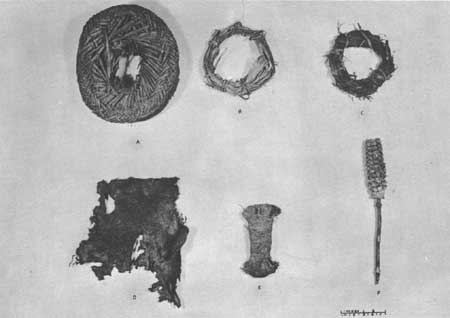
|
| PLATE 29—Fiber artifacts A — twilled yucca head-ring; B — ring made of yucca strips; C — ring of juniper bark tied with yucca strips; D — cotton cloth, plain weave; E — bundle of yucca fibers tied with small yucca cord; F — corncob on stick. All from upper Room 11. |
Carved Pahos
During stabilization work on Room 23, which had been excavated many years ago, we found in the north wall two unusual vertical channels 2 inches square and 3 feet high; one of these was empty and the other contained the two carved pahos shown in plate 30A, B. These are straight sticks, probably cottonwood, whittled to shape and smoothed. The tops are carved into two lobes separated by a convex, barrel-shaped portion three-fourths inch long. The upper lobe is bevelled above and below, and the sides are flattened, terminating in a dull point. Below the barrel is a raised collar one-fourth inch wide. Although the distal ends of the pahos are broken enough remains to show that they were pointed. Moreover, they appear to be painted all over in black, although this could be a heavy encrustation produced by age. The specimen in plate 30A is 14 inches long, and one-half inch in diameter at greatest dimension at carved portion of the head or tip, 30B is 13-1/4 inches long and one-half inch at greatest diameter.
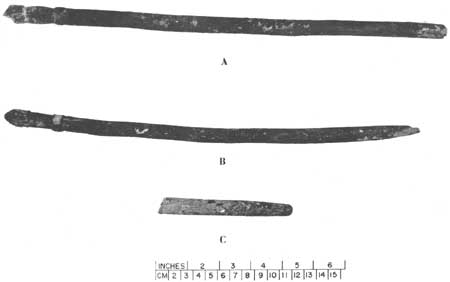
|
| PLATE 30—Pahos A and B — carved and painted pahos found lodged vertically in wall core, corner of Room 23; C — fragment of painted stick from upper Room 12. |
In the general fill of upper Room 12 was found one end of a stick with a blunt point (plate 30C). This fragment is 14-1/4 inches long and one-half inch in diameter at greatest width and resembles the lower portion of a paho. It bears a layer of red paint.
In the tower at Mummy Cave in Canyon de Chelly in 1932, Morris found an alinement of carved sticks, crook sticks, and little bows set vertically in the core between the face courses. Later examination showed that the southwest corner of the tower had a similar alinement, clearly evident for several feet down from the top (1941: 227). Although small bows and crook sticks did not accompany the two carved sticks in the core of the East Ruin wall, the latter are "dead ringers" for those found by Morris at Mummy Cave. There are an additional two in the Preservation Laboratory collections which came from room fill in the West Ruin.
Morris reported two similar finds at Mesa Verde in Cliff Palace and another in Balcony House. He viewed these similar, if not identical, finds as one more point to indicate that the tower in Mummy Cave was built by immigrants from Mesa Verde. The latest timbers in the tower were cut in 1284, which fact dovetails nicely into an assumption that the north country was abandoned during the great drought which began in 1276 (1941: 227-230).
By the same token, I think it can be safely said that the finding of identical prayer sticks in the walls of the East Ruin is another indication that it was a pueblo of the Mesa Verde Branch, the only difference being the location: the East Ruin was built in the open rather than in a cliff.
Mummy Cave Tower and the East Ruin are further linked culturally in that both are constructed of Montezuma Phase masonry and contain identically made pole sill doorways.
Judging from their widely reported distribution in Pueblo III sites, prayer sticks are probably a trait of the Anasazi culture which spread to the Hohokam and Mogollon.
Willow Mat
Two willow sticks came from high in the fill of upper Room 13 (plate 28C). Both are pierced in the centers, with one having a yucca cord strung through the perforation. One end of the strand has two overhand knots to prevent it slipping through the hole. In size, makeup and intended function they appear comparable to the component parts of a strung willow mat curtain or doorway ("venetian blind") that can be seen in one of the West Ruin doorways today.
Haft for Ax or Maul (plate 31A)
A complete handle for either a maul or an ax was found in the fill above floor of upper Room 14. It is a tough, close-grained, small branch pulled and not cut from the tree. At a point equidistant from both ends it was bent and looped back on itself with some twisting motion so that both arms of the handle were parallel. The handle end is tied with two separate strands of yucca leaf, whereas the tie across the base of the loop, also with strips of yucca leaf, was wrapped around each side of the doubled-back branch as well as across the pair to make a secure haft for the stone implement it once held. Present length of the specimen is 18-1/2 inches.
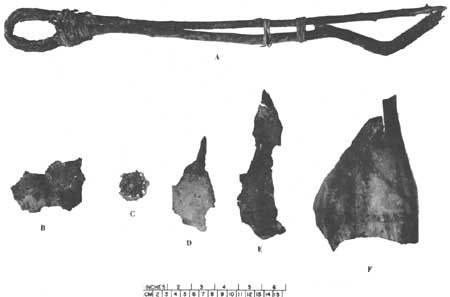
|
| PLATE 31—Haft and vegetal remains. A — haft and handle for an ax or maul, upper Room 14; B through E — squash rinds, Cucurbita pepo, upper Room 11; F — decorated gourd (Lagenaria) container fragment, upper Room 14. |
Bone
Bracelet or Pendant
A fragmentary bracelet or pendant of thinly worked bone came from near the east wall top of Room 15. The object (plate 32) is 1-1/2 inches wide, 2-1/8 inches long, and varies from less than one thirty-second to one-eighth inch in thickness. It has two drilled holes at the end, each near the edges. An incised decoration consists of three longitudinal grooves dividing the face or upper side of the ornament into two bands. The bands contain incised V's lying on their sides; in one band the V's lie with the open ends toward the end of the ornament, and in the other the V's are reversed in direction and face the opposite, missing end. The incising has a maximum depth of one-eighth inch. The undecorated side is longitudinally concave; the decorated side, convex.
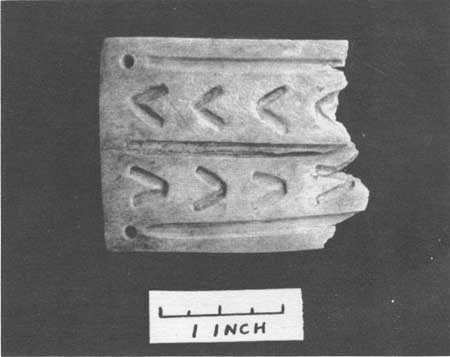
|
| PLATE 32—Bracelet or pendant. Fragmentary bracelet (?) from area between southwest corner of unexcavated kiva and east wall of Room 15. |
Size and shape suggest possible use as a bracelet. Grinding and polishing marks are evident throughout. The perforations, apparently designed either for suspension or fastening rather than inlay, were largely drilled from the upper side. The bracelet is broken transversely at or near the former center, and it is probable that the opposite, missing end had two corresponding perforations.
At least two similar bracelet fragments of thinly worked bone have been found in Pueblo Bonito (Pepper 1920: plate 12, figures 2 and 3). Another example is noted from the West Ruin near Kiva R by Morris (Cat. AR-2553). None of these comparative specimens are as well made nor as ornate as the one from the East Ruin, but they show unmistakable resemblances in size, and form.
Bone Awls
Three bone awls were found, and a fourth specimen probably represents an awl in process of manufacture. One was made of the ulna of a bighorn sheep (Ovis canadensis). The head is unworked; the specimen is 7-1/8 inches long, 1-3/8 inches wide at the base, and was from general fill of Room 24. A second specimen, also from Room 24, is the proximal end of a split radial bone of either deer or bighorn. Although the head of the bone is intact, it has been altered considerably by wear and use. The shank has a high polish and a shallow depression with transverse friction marks, exceptionally polished, which may indicate its use as a weaving tool. It is 30-3/4 inches long, seven-eighths inch wide at the base.
A third awl from fill in upper Room 12 is made from the proximal end of a split tibiotarsus of a turkey (Meleagris gallopavo merriami). The head is broken and deteriorated. The shank was broken and split just below the head, and the tip ground to a long, sharp point. It is 3 inches long, three-fourths inch wide.
Another example is a tarsometatarsus of a turkey, split longitudinally at a point 1-3/4 inches below the proximal end. The head is unaltered. The distal end was removed, and near the end of the longitudinally split portion the two edges were ground to a rounded point. Evidently this is a bone awl in the early stages of manufacture. Measuring 4-1/2 inches in length and seven-eighths inch in width at the base, it came from the area west of Room 1.
Other Worked Bone
Three additional bones, two of which are distal portions of the tibiotarsi of turkeys, were found, apparently from which either tubular beads or whistles were made.
In the third, the proximal end of the left humerus of a turkey, the severed end was cut transversely and ground smooth. Upward three-eighths inch from this smoothed end is an incision completely encircling the shank, as in the process of making another bead.
Antler, Horn, and Hoof
Flakers
Two tines came from the dry refuse of upper Room 11. The tip of one illustrated in plate 33a is worked, showing two grinding facets. It is 6-1/4 inches long and seven-eighths inch wide at base. The butt is rough and shows hacking or sawing marks where it was detached from the shaft of the horn.

|
| PLATE 33—Artifacts of antler. a and b — flakers (?) of antler, both from upper Room 11; c — worked antler from lower Room 14. |
The other tine (plate 33b) is broken both at the tip and butt, although it shows some wear and is fire-scarred. It measures 5-3/8 inches in length and five-eighths inch in width at the butt.
Other Worked Antler
A third piece of antler came from the floor of lower Room 14. It is a midsection of the tine cut square on both ends (plate 33c). Use is unknown but it appears to have been prepared as a handle, because one end shows what seems to be the beginning of a socket to receive the base of a tool such as a knife or chisel. It is 4-3/8 inches long and seven-eighths inch at greatest diameter, fitting very conveniently in the palm of the hand.
Hoof
One fragment of a deer (?) hoof was found in the dry refuse of upper Room 11. It was not perforated nor did it show any kind of wear or use to give a clue as to its intended purpose. Morris found several deer or antelope hoofs in the West Ruin, each pierced near the upper edge and strung on yucca cords which he believed were portions of a rattle (1919: 63).
Horn
A right horn core (plate 34A) and an intact horn core set (plate 34B) of bighorn sheep (Ovis canadensis) came from the dry rubbish in the lower 3 feet of fill in upper Room 11. The single horn core is 13-3/4 inches from base to tip. The intact pair of horns measure 10-1/4 inches from former point of attachment at the cranium to the tip ends.

|
| PLATE 34—Horn cores. A — right horn core; B — intact horn core set from bighorn. Both specimens from Upper Room 11. |
In general both the horn or sheath and core of bighorn sheep, as well as bones of this animal, played an important part in the economy of the people at Aztec. While artifacts of horn and core are not plentiful, those made from sheep bone are nearly as frequent as those from deer. No artifacts of sheep bone or horn are reported from Mesa Verde (Lancaster, Watson et al. 1954; O'Bryan 1950) although it is listed in the bulk bone material (O'Bryan 1950: 133). Whether this is due to the vagaries of collecting, unfavorable preservation, or relative scarcity of sheep on the Mesa Verde, is an open question. Particularly in early stages following their detachment from the animal, horn and antler are quite susceptible to both rapid weathering and consumption by rodents which may largely account for their general scarcity.
In the West Ruin collection of the Preservation Laboratory is a large slanting blade (11 inches long) with a round handle made of horn core, which could have been used for scraping, fleshing, or possibly as a baton (Cat. AR-2154). Two other objects, one of horn, the other of core, are listed for the West Ruin, but they, like the single horn from the East Ruin, cannot be positively identified as artifacts, owing to their weathered condition. Morris mentions finding sheep horns, and sometimes hoofs, throughout the West Ruin (1928 passim). And it is interesting to note that he found the core of a left horn of a large bighorn sheep in a wall pocket of a kiva in the Aztec Ruin Annex (1924: 247), which might raise question as to whether horn sets were possibly used by participants in ceremonial fashion, or whether they may have been a part of either fixed or movable paraphernalia in the kiva proper. At present there is no direct evidence in support of such use. However, a suggestive analogy may be found in a modern pueblo. In a kiva at Isleta (1935) there are sets of deer antlers suspended along the circular wall a few inches beneath the roof (personal communication, R. G. Vivian).
Bighorns are perhaps the most common subject of pictographs in cliff sites of northeastern Arizona (Kidder and Guernsey 1919: 193), indicative of the importance ascribed to this game animal by the Anasazi. At least three types of bighorn sheep horn implements were found in that locality: scrapers, wrenches, and a spindle whorl (see Kidder and Guernsey 1919: plate 46A, c, d, and e; and plate 51, c, respectively).
Basketry
Basketry is represented by one fragment of either a plaque or tray, from upper Room 12. The direction of work is from right to left, close coiling; simple stitch, uninterlocked; two-rod-and-bundle foundation, bunched. It has a normal center. There are 6 coils and 12 stitches to the inch and the rods average one-sixteenth of an inch in diameter. No color decoration could be detected. The material is unidentified but appears to be willow.
From his earlier work Morris (1919: 56) describes both coiled and plated basketry from the West Ruin, although none of the 24 presumably complete baskets from it were included in the study series by Morris and Burgh (1941: 13) due to limitations of time. It was felt justifiable to omit them since most belonged to the Mesa Verde period (Montezuma Phase) already well represented in the series. The better specimens are on display in the Visitor Center at Aztec Ruins National Monument.
Matting
Fragments of two twilled rush mats were recovered, one from upper Room 12 and the other from upper Room 14. Mats were one of the usual cerements in burials at Aztec (Morris 1924 passim).
The weaving is over-two-under-two. The material may be either a rush (Juncus sp.) or the leaf or flattened stem of cattail (Typha sp.). The selvage is a continuation of the body elements slanting at an angle from them, with none of the elements cut where the selvage begins. However, a pair of twined rushes is inserted, serving to hold the elements firm at a point just before they are bent at an angle to form selvage. At the border the warps and wefts are doubled back into the selvage and at the inside border are doubled back in the same fashion, leaving a short flap on the underside of the mat.
Enough of the corners remain to indicate that the same type of selvage bordered all four sides, and that the corners of one mat are nicely curved or rounded while in the other, the corners are roughly squared. No patterns in the main body, such as concentric squares or chevrons achieved by variously manipulating the warp and weft, were discernible. Mats from the East Ruin are similar to those from Mesa Verde (Nordenskiold 1893: 4) and northeastern Arizona (Kidder and Guernsey 1919: 112).
One mat was coarsely made, the rushes varying considerably in width from three-sixteenths to one-half inch; the uneven selvage averages 1-3/4 inches in width and the specimen is 2 feet long. The second mat, from upper Room 14, is finely plaited of smaller elements and the rushes were either uniformly graded or trimmed to size. Here the selvage measures 1-1/4 inches wide; the elements are one-fourth inch wide, and the largest of several fragments of the mat is 18 inches long.
Cordage
The terminology used in this paper follows Dixon 1956 and Kent 1957. In referring to yucca, yarn is a bundle of loose bast fibers which have been twisted together; a strand refers to two or more yarns twisted together. A vertically held yarn or strand is Z-twisted if the fibers of the yarn trend from right to left. A vertically held yarn or strand is S-twisted if the fibers spiral down from left to right, following the center line of the letter S. When referring to cotton, yarn is a bundle of loose fibers which have been spun together to form a single continuous thread. This is a single-yarn thread. A single-yarn thread in which the fibers parallel the diagonal center line of the letter S is S-spun. A single-yarn thread in which the fibers parallel the diagonal center line of the letter Z is Z-spun.
Distinction of terms between yucca and cotton is made on the basis of the two different methods by which yucca and cotton yarns are made. A yarn of yucca was made by twisting together the individual fibers by rolling them between the hand and thigh (Kent 1957: 478), while cotton was spun from a lap of loose fibers with the aid of a spindle (ibid: 472).
Yucca Cordage
Thirty fragments of yucca fiber cordage came from the East Ruin, most of it from upper Room 11. The only cotton cordage found was included in a border for the plain weave cotton fabric described under Textiles.
In all cases, with one exception, the strands are two-yarn, the yarns S-twisted, and the strands Z-twisted. The cordage varies in size from one thirty-second of an inch in diameter to a rope three-fourths of an inch in diameter. An example of the smallest cordage is shown in the wrapping around a bundle of yucca fibers (plate 29E). The most common examples are from one-eighth to one-fourth inch in diameter (plates 35C, 36B and C).
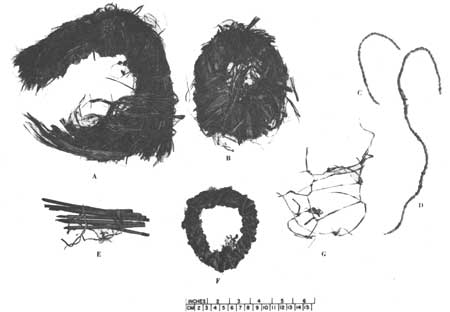
|
| PLATE 35—Fiber and cordage. A and B — juniper bark pot rests; C — yucca cordage; D — strand of feather cloth; E — reed stems laced with twined strips of yucca leaves; F — ring of yucca cordage; G — yucca strand netting. All from upper Room 11. |
Of special interest is the short but thick and strong loop of rope shown in plate 36A. Beginning with the larger elements first, it is composed of three S-twisted strands; each strand is Z-twisted. and is made up of two S-twisted yarns. Thus, the component elements of the rope are three strands totaling six yarns. Formed into a loop, it suggests use for carrying or suspending a heavy object.
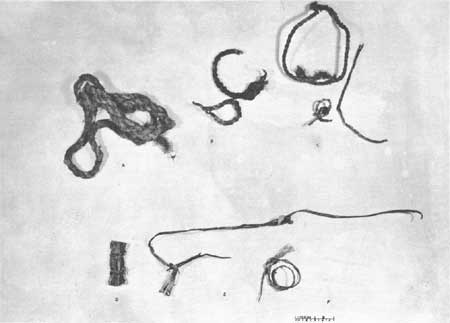
|
| PLATE 36—Yucca cordage and strips. A through C — yucca cordage; D — small bundle of yucca leaves tied with strips of yucca; E — bundle or burden strap of yucca; F — coil of yucca strip. All from upper Room 11. |
Hair cordage was not found although it is reported for the West Ruin.
Feather Cloth
It was represented by a single example of a yucca cord (plate 35D) wrapped with quills, in poor condition, with only three or four turns or twists of quills remaining. The cord is made of two yarns of yucca fiber. The individual yarns are S-twisted, and the two yarns forming the strand are Z-twisted. The few turns of quills remaining are wrapped around the cord in an S-twist. Specimen is 12-1/2 inches long, and the foundation cord is one-eighth inch thick. This single element was probably once part of a feather-cloth robe similar to specimens in the Preservation Laboratory from the West Ruin.
The prehistoric Anasazi used fur cordage during Basket Maker II and III, from about the beginning of the Christian era to A.D. 750, although feather cordage made its appearance in Basket Maker III, probably contemporaneous with the capture and domestication of the wild turkey. In Pueblo III feather cordage is predominant (Nusbaum, Kidder, and Guernsey 1922: 104; Kidder and Guernsey 1919: 174).
Yucca Leaf Bundles
There are two small rectangular bundles of yucca leaves, folded and packed so the ends do not unravel. They were tied, one with strips of yucca leaf near the ends, the other about the middle with strips and a wrapping of two-yarn yucca cord. Both were from upper Room 11 and probably represent a method of stowing raw material for future use.
Ball of Yucca Cordage
Reversed from the usual pattern the cordage is of two loosely Z-twisted yarns, loosely S-twisted into a strand. The ball is tied with a very thin two-yarn yucca cord of the usual twist (yarns S-twisted; strand Z-twisted). The Z-twisted yarns could have been produced with a spindle, or may be the work of a left-handed person; both may be wrong. It may have been merely the result of reversing the usual right-hand (S) twist for producing yucca yarns from fiber. To our knowledge, it is not yet possible to determine the method employed in producing a particular yarn with out either direct evidence of observing manufacture or of yarn attached to spindles.
Bluhm and Grange (Martin, Rinaldo et al. 1952: 205-211) give an interesting, though admittedly theoretical, discussion on this problem which will require further research before it may be fully resolved.
Yucca Netting
This is a very small fragment of what appears to have been a net (plate 35G), with only two or three large meshes intact. It is made of cut strips of yucca leaf, the intersections of central meshes being tied with overhand knots while those at the edge of the net are tied with reef knots. Intact meshes average 1 inch wide, 2 inches long. Use is problematical. It may have been useful in carrying light though bulky materials; or possibly as a snare; or as a drier for herbs and agricultural products. It came from upper Room 11.
Cylindrical Reed-stem Container (?)
Plate 35E illustrates a bundle of nine very slender reeds (Phragmites communis), laced at an interval of 2 inches with twined strips of yucca leaf. Present average length of the object is 4 inches. At one end, all reed stalks are charred, suggesting possible use as a torch. On the other hand, it resembles the cylindrical container mentioned by Morris (1919: 59) in which he suggested that these were sheaths for the protection of feathers and plumes used in ceremonial rites. He mentions that one of these reed-stem cylinders is enclosed in a wrapping of cornhusks, bound in place with yucca cord (ibid.).
Whatever may have been their use, it should be noted that out of several similar specimens in the Preservation Laboratory all except one are charred at one end only, like this example from refuse in upper Room 11.
Knot and Ties
From the dry refuse in upper Room 11 came a fair sampling of knotted pliant sticks. In many cases these were probably for tying bundles of raw materials such as yucca leaves for basketry and matting, juniper splints and bark for roofing, for carrying agricultural products, etc. Some suggest that they are broken and discarded carrying straps. Three types of knots were noted in order of frequency: reef or square knot, overhand, and figure-of-eight.
Pot Rests
At least three types are represented, all coming from organic refuse in upper Room 11: (1) twilled, of graded yucca leaves, (2) of either shredded juniper bark or bunched and coiled strips of yucca leaves, and (3) those made with yucca cordage.
The finest, and only example of the first type (1), is a head ring or pot rest of twilled, narrow yucca leaves in an over-two-under-two weave (plate 29A). Viewed from the top, it appears doughnut-shaped; one side is flat, the other concave. The central part of the outer circumference is constricted all the way around by a tight wrapping of split willow (?), giving the edge a "pulley" effect. This wrapping may have served the dual purpose of both retaining original shape and providing some resilience to an object which supported weight and may have been worn on the head. Outside diameter is 4-7/8 inches, diameter of the opening at the center is 1 inch, average thickness is 1-1/4 inches.
There are four of the second type (2); three are of bunched juniper bark, two tied with bark, and the other with strips of yucca. A fourth is of coiled strips of yucca with a spiral wrapping of the same material.
A single example of a yucca cordage pot rest has a foundation of three revolutions of a heavy, loosely twisted normal two-yarn strand, this wrapped and tied with a smaller, normal cord; the pot rest is 3-1/2 inches in diameter.
Corn Stems on Stick
Strung on a willow loop (Salix?), like keys on a ring, are two stems of corn ears. A number of such rings of corn were found in the West Ruin (Morris 1919: 62). Presumably these loops with suspended corn were hung up for drying, with the ears subsequently broken off as desired for use. Length of stick is 17 inches. It was from the refuse in upper Room 11.
Textiles
Cotton Cloth
There is one fragment, from upper Room 11. Only 4-1/4 by 5 inches, there is no hint of its original form (plate 29D). It is a plain weave in natural, brownish-gray without design or decoration. The warp threads are more tightly spun than the weft. There is a border on one side only, made of two S-twisted strands, each strand containing three Z-spun yarns. This border cord is twined through loops of warp yarns, with a half twist of the cord alternating between each warp loop. The warp count averages 25 to the inch, the weft 23 to the inch. Warps and wefts are all single yarn and Z-spun. characteristic of Southwestern cotton plain weaves.
Kent (1957) lists the following finds at Aztec, citing Brand (1937), Morris (1919 and 1924), and Smiley (1951): seeds and fiber; thread, disc whorls and yucca needles, batten (?) plain weave; plain weave tapestry tumpline; twill breach cloth (?); Anasazi twill blanket; diamond twill. The fabrics are said to be primarily mummy wrappings from the Mesa Verde Annex. In this connection, however, we note that out of 186 burials at Aztec (Morris 1924: 224-225) cotton cloth is shown as having been found with only 7 bodies, and that none of these include burials from the West Ruin Annex. Possibly they were recovered and taken to the University of Colorado Museum after his 1924 publication, at which time they were seen and studied by Kent.
Miscellaneous
Worked Sherds
There were three worked sherds, two roughly rounded and the third triangular. All are from bowls and are unperforated. One is a disc of Chaco Black-on-white, a miscellaneous surface find, another a disc of Mesa Verde Black on-white, while the third is a triangular rim sherd of Mancos Black-on-white.
Feathers
The dry fill of upper Room 11 yielded several loose feathers identified by Lyndon Hargrave as from turkey.
Egg Shells
Several fragments of egg shell, large enough to have been from turkey came from upper Room 11.
Pitch
In a large sherd from the bottom of an indented corrugated jar, was a thick residue of resinous pitch. The sherd may have been a crucible for pitch used as cement or as a coating for baskets.
Gourd (plate 31F)
A gourd fragment, charred along one edge, came from disturbed contents of upper Room 14. It was identified as a thin-walled bottle gourd (Lagenaria) by Hugh Cutler, who also noted that it had been picked before ripe and then peeled, leaving narrow, incised bands around the body.
Unfired Clay
A chunk of adobe bearing impressions of a single corn cob was found in lower Room 11. Obviously part of an originally larger object, it may have served as a jar stopper.
Pottery
Like so many other late Pueblo III sites of the Mesa Verde Branch, the East Ruin shows a lack of diversity in indigenous ceramic types. In fact, the purity of the collection is the most significant clue to the cultural identification of the site, with Mesa Verde Black-on-white representing over 90% of the total decorated sherds. Since reliable stratigraphic sections were found in such few instances, it must be said that our evidence lies largely in gross sherd counts. Sherds near floors and 5 to 6 feet above, except as noted in the following comments on individual pottery types, showed no discernible change.
Both decorated and utility sherds were used as chinking material in walls. Logically, both early and contemporary sherds would be used as spalls, and this appeared to be true from random examination; the spalls included Indented Corrugated, Mancos, McElmo and Mesa Verde Black-on-whites as well as intrusives. Refuse areas on three sides of the West Ruin were possible sources, as sherds were brought to the East Ruin for use both as temper in pottery and as spall material.
Although all sherds recovered were saved, the total for the excavation was only 3,448, with no complete vessels found.
As the major wares have been described in detail elsewhere (Morris 1939, Brew 1946, Reed 1958, Kidder 1924, Abel 1955), only a brief survey will be included here, along with observations on amounts and percentages, and a few comments pertaining to temper based on examination under an X45 binocular microscope. It was possible to distinguish clay, sand, crushed rock and sand, and crushed sherd inclusions. Only a petrographic analysis could give an accurate content of temper. We also admit to possible errors of identification between Mancos Black-on-white and Chaco Black-on-white and between McElmo and Mesa Verde. Since Chaco, Mancos, and McElmo sherds were so sparse, we believe that possible errors would not materially affect the results.
The following are the pottery types recovered from the East Ruin, as classified after Colton (1955 & 1956).
Mogollon Brown Ware
Reserve Series
Reserve Indented Corrugated, smudged interior
Shiwanna Red Ware
Wingate Black-on-red
Wingate Corrugated
Puerco Black-on-red
St. Johns Polychrome
Querino Polychrome
Tsegi Orange Ware
Tusayan Black-on-red
Tusayan Polychrome
Mesa Verde Gray Ware
Mancos Corrugated
Mesa Verde Corrugated
Mesa Verde White Ware
McElmo Black-on-white
Mesa Verde Black-on-white
Cibola White Ware
Puerco-Chaco Series
Chaco Black-on-white
San Juan Series
Morfield Black-on-gray
Mancos Black-on-white
Cortez Black-on-white
Decorated Wares
Mesa Verde Black-on-white (plates 37, 38): ca. A.D. 1200-1300 (Abel 1955). This ware is the dominant decorated pottery of the site, comprising 91 percent of decorated types, and 92 percent of black-on-white types. In some rooms, it ranged from 95 to 100 percent of all black-on-white sherds. Bowl shapes predominate over jar shapes in the collection by a ratio of 2:1.
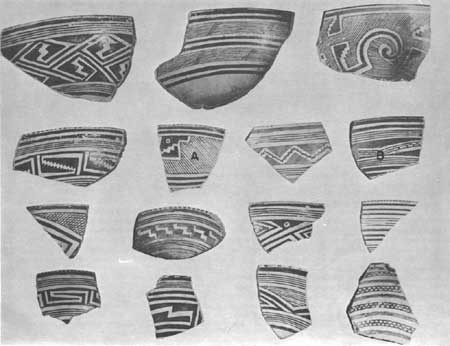
|
| PLATE 37—Mesa Verde Black-on-white sherds. Large Mesa Verde Black-on-white bowl sherds, interiors. All from general fill, upper Room 14. |
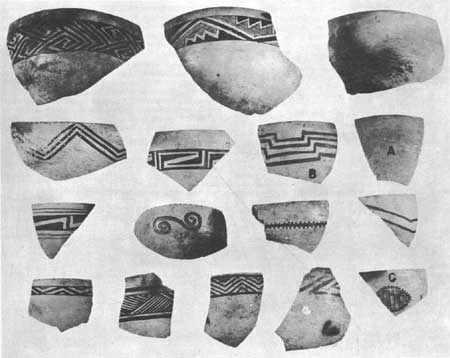
|
| PLATE 38—Mesa Verde Black-on-white sherds. Sherds in plate above have been reversed to show exteriors. One sherd, C, has been added. |
Both large and small water and storage jars are represented, and mugs, though present, are rare, with only 8 in a total of 1,691 sherds. Abel (1955) states that Mesa Verde Black-on-white has sherd temper, but the majority of Aztec sherds are tempered with crushed rock and sand, as in the Mesa Verde Black-on-white of the La Plata River area (Shepard in Morris 1939: 276). He also describes a "new" variety, Mesa Verde Polychrome. We noticed a few sherds of this description but did not make the separation, as the time element is the same.
With respect to the beginning date for Mesa Verde Black-on-white, we are dealing here with a highly standardized design and form. Included in this distinctive style are: mugs, hollow-handled ladles, kiva jars with a molded rim, thick-rimmed bowls decorated both on interiors and exteriors, water jars, spherical and submarine-shaped canteens, all well-polished in a pearly white and decorated with heavy geometric designs in organic paint. When the above criteria are applied, few workers would see anything much earlier than A.D. 1200 for the type.
McElmo Black-on-white: ca. A.D. 1130-1200 (Abel 1955). Comprises 2.9 percent of black-on-white types, and is the third ranking ware among them. This ware marks the introduction of carbon paint to the San Juan area. Abel suggests it may have been introduced by the Virgin Branch of southwestern Utah, southern Nevada and the Arizona Strip (1955: 3). Trade contacts thus far noted at Aztec indicate that carbon paint could just as easily have arrived from the Kayenta or Little Colorado districts. In fact, McElmo bears a predominantly wide line decoration in Sosi style which might argue for its inspiration out of northeastern Arizona.
Temper appeared more variable than in Mesa Verde Black-on-white. Some sherds had an extremely fine paste, virtually of untempered clay, with stray fragments of either sherd or light colored rock. The temper in a majority of sherds was fine, containing minutely crushed dark rock. Abel gives temper as crushed sherds with occasional particles of crushed rock in some sherds (1955).
Discussion
Lancaster (1954: 78) believes that neither McElmo Black-on-white nor any Pueblo III black-on-white pottery was made prior to A.D. 1100 in the Mesa Verde. This is in disagreement with O'Bryan (1950: 109), who assigns McElmo Black-on-white a beginning date of A.D. 1050, which might argue for the genesis of McElmo in the area either to the northwest (Lowery Ruin) or to the southwest (La Plata district) of Mesa Verde.
Most workers agree that the change from iron to carbon paint implies experimentation begun perhaps by introduction of new ideas or a migration of people, and the only points of disagreement seem to be a more precise date for this change, and as to direction of movement, with the majority opinion favoring a general north to south trend.
The important point in concluding this discussion is that, regardless of one's interpretation of the evidence concerning origin and movement of McElmo Black-on-white, it was clearly on the wane when the East Ruin was occupied.
Mancos Black-on-White: ca. A.D. 950-1150 (Abel 1955). Constitutes 4.4 percent of the decorated pottery, and 4.5 percent of the black-on-whites. It is the second ranking ware in the black-on-white category. Abel gives crushed sherd as the temper. He also divides this into two types: Morfield Black-on-gray (ca. A.D. 950-1100) and Mancos Black-on-white (A.D. 950-1150), on the basis of form and finish. Obviously, these two types overlap in both time and technique and, until this separation was made by Abel, all were included in Mancos Black-on-white.
The most significant observation on Mesa Verde, McElmo and Mancos Black-on-white sherds from the East Ruin is the noticeable predominance of crushed rock and sand temper versus the crushed sherd temper of the same types at Mesa Verde (according to Abel). Vivian found this same situation to be true for sherd material from the Hubbard Site (1959: 31), and Shepard reports the same for the La Plata area (Morris 1939: 275).
Cortez Black-on-white: ca. A.D. 900-1000 (Abel 1955). It is represented by a single sherd, and considered a drift spall. It has a good slip and polish, mineral paint, and crushed rock temper.
Intrusive Decorated
Chaco Black-on-white: ca. A.D. 1100 (Hawley 1936: 43-44). Our sherd counts show three of this type. Two may be Mancos copies of Chaco Black-on-white, and one is a Chaco Black-on-white worked sherd disc, coming from the surface of the mound.
Puerco Black-on-red: A.D. 1050-1175. Only two sherds of this type were found, one in good stratigraphic position between the two floors of lower Room 11 in association with Classic Mesa Verde Black-on-white. These two examples have square rims, and wide line decoration identical to McElmo Black-on-white, except of course, for the heavy red slip. Colton and Hargrave (1937) discussed the ancestry and identity of the type. Later studies raised the time range, viewing the type as a late development from Wingate Black-on-red in simple, bold, linear designs.
Wingate Black-on-red: A.D. 975-1125 or extending to 1125-1200 if the North Plains variety is included. Nine sherds of this type were found, seven of them, including one with a corrugated exterior, in undisturbed fill of upper Rooms 9 and 11; at least one fits Dittert's description of the North Plains variety (1956: 303).
Querino Polychrome: A.D. 1250-1300 (Colton and Hargrave 1937). Only three sherds were found; two came from undisturbed situations of upper Rooms 9 and 11, the third from either doubtful or secondary deposition in lower Room 8.
St. Johns Polychrome: A.D. 1150-1275 (Kidder and Shepard 1936). Also represented by just three sherds from fill of lower Room 8, and upper Rooms 12 and 13, all probably of secondary deposition.
Tusayan Black-on-red: ca. A.D. 1050-1150 (Colton and Hargrave 1937). Two sherds were found in reliable association of undisturbed contents of upper Rooms 9 and 11.
Tusayan Polychrome: A.D. 1150-1300? (Colton 1946). Three sherds from lower Room 11 were found in drifted, and not occupational, deposit.
Tsegi Orange Ware: Unidentified, probably of the Black Mesa Series (Colton 1946). Total of three sherds, two from reliable deposits in Room 24, the other in redeposited fill of upper Room 12.
Local Utility Ware
Locally made utility ware comprised a total of 1,590 sherds or 46 percent of all types, decorated and utility combined. These ranged from a few plain sherds (19), through incised (3) to deeply indented, sometimes patterned corrugated which are comparable to exuberant or Mancos Corrugated (78) (Abel 1955) to finally the great majority of Mesa Verde Corrugated (1,490 sherds) (Abel 1955), or what Reed appropriately terms "Standardized Corrugated" (1958: 121).
The plain and incised sherds are of somewhat doubtful placement, probably holdovers from late Pueblo II. Since all were found either in the intentional fill between floors of the kiva over Room 1 or in the disturbed area above the third and final floor of the kiva, they may represent material carried in from various refuse areas for filling the space between floors, or construction of the kiva roof.
Abel gives crushed rock as temper for both Mancos and Mesa Verde Corrugated (1955). The only difference we could detect in the East Ruin examples is that toward the later end of the time scale (Mesa Verde Corrugated) the paste trended more to temper with dark crushed rock, sand, and occasional pieces of sherd, and was thus allied somewhat closely with its companion decorated ware, Mesa Verde Black-on-white.
Except for the few plain and incised sherds, the individual room summaries noted earlier do not give the breakdown for Mancos and Mesa Verde Corrugated; rather they are lumped together under "Indented Corrugated."
A summary breakdown for utility ware for the site as a whole is as follows:
| No. | Percent | |
| Plain Ware (unidentified), probably late Pueblo II | 19 | 1.2 |
| Incised Ware, late Pueblo II, early Pueblo III | 3 | .1 |
| Mancos Corrugated, Pueblo II and early Pueblo III | 78 | 5.0 |
| Mesa Verde Corrugated, Pueblo III | 1,490 | 93.7 |
| Total | 1,590 | 100.0 |
From the above figures it will be seen that the dominant utility ware, Mesa Verde Corrugated, compares percentage-wise to the total utility ware in approximately the same amount that its companion ware, Mesa Verde Black-on-white, compares with the total black-on-white varieties.
Intrusive Utility Ware
Reserve Indented Corrugated, smudged interior: ca. A.D. 1050-1250 Reserve and Tularosa Phases, Pueblo II and III (Rinaldo and Bluhm 1956). There was one sherd, from lower Room 14. Vivian found a sherd or two of this type in 1949 while clearing upper Rooms 2 and 4 (personal communication). Morris also found a variant, a Tularosa Patterned Corrugated rectangular dish, in the West Ruin (1919: 73-74). The several occurrences of this unmistakable, burnished interior ware bespeak definite trade, either directly or through intermediary sources, from the Tularosa region of southwestern New Mexico.
Atypical Sherds From Upper Room 14
On the assumption that it may sometime be definitely proved, either through documentary sources or eyewitnesses, whether or not the redeposited sherds in upper Room 14 came from the East Ruin or elsewhere within the Monument, the sherd types which are not duplicated in preceding descriptions are briefly listed, along with a few comments. The several archeologists noted in the preface gave us their opinions on these sherds, providing basis for the following identifications.
Klagetoh-Kowina Black-on-white: ca. A.D. 1250-1300 (Colton and Hargrave 1937; Wendorf 1956: 319). Total of six sherds, three from a jar or pitcher. Temper appears to be finely ground sherds. Description most nearly resembles Klagetoh Black-on-white. Superficially, mainly on the basis of design, it appears to be a late variant of Tularosa Black-on-white.
Pinedale Black-on-red: A.D. 1200-1300 (Colton and Hargrave 1937). Total of 31 sherds. There was considerable disagreement among specialists regarding this group, with a majority vote for Pinedale Black-on-red.
Springerville Polychrome: A.D. 1300? Total of 15 sherds. The writer would have placed at least some of these in Keet Seel Polychrome an opinion shared by three other individuals. Others suggested that the sherds are not Keet Seel Polychrome but related to St. Johns Polychrome, a type called by Danson (1957) Springerville Polychrome, not yet described. I will now settle for the latter opinion.
Klagetoh Polychrome: ca. A.D. 1250-1300 (Colton and Hargrave 1937). Represented by 83 sherds.
Tularosa Patterned Corrugated: ca. A.D. 1050-1250 (Rinaldo and Bluhm 1956). One partly restorable, rectangular dish. There is no question regarding its identity.
Mogollon Brown Ware: Woodruff Brown? pre-A.D. 800 (Colton and Hargrave 1937). Represented by a partly restorable miniature bowl. This may be the "joker" of the lot. Only one individual out of the seven or eight people who examined it ventured the opinion that "it looks like Mogollon Brown Ware, types Woodruff Brown or Forestdale Plain." For all the writer knows, it may be modern. None of the other archeologists would commit themselves at all.
It appears futile to pass judgment on sherds which may be of false deposition. Yet, with the exception of the last-mentioned they date between A.D. 1100-1300, with most of them ranging in the 13th century, and we see nothing that would extend later than A.D. 1300. Only within this narrow temporal sense could these sherds conceivably be in place at the site.
| <<< Previous | <<< Contents>>> | Next >>> |
wnpa/tech/4/sec4.htm
Last Updated: 10-Jan-2008
Western National Parks Association